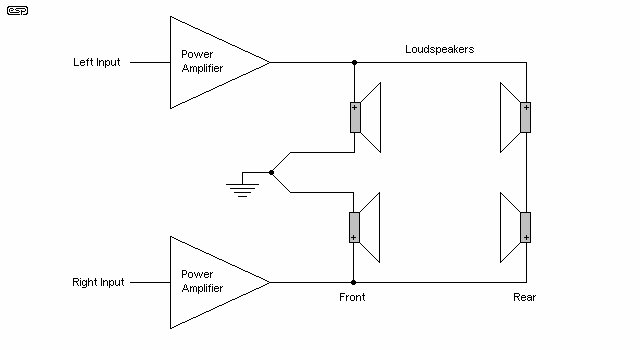 This scheme actually works and takes advantage of the fact that in a live performance, the distance between the audience and the performers is great enough that there's a phase difference between them. Thus, the audience is out of phase with the performers and that difference is played on the rear speakers. When you play studio recordings there's always enough phase differences to light up the rears and you get a sense of surround sound.
It's more of a fun project than anything I recommend, but that's what we're here for.
This scheme actually works and takes advantage of the fact that in a live performance, the distance between the audience and the performers is great enough that there's a phase difference between them. Thus, the audience is out of phase with the performers and that difference is played on the rear speakers. When you play studio recordings there's always enough phase differences to light up the rears and you get a sense of surround sound.
It's more of a fun project than anything I recommend, but that's what we're here for.
4-channel audio
by Paul McGowan
There's a lot of information in a stereo recording that some systems don't reproduce well. In fact, most systems keep the room cues and ambiance locked away in our recordings.
One way to unlock them is by careful 2-channel setup and the very best electronics. Like what we've done in Music Room Two with our BHK electronics and IRSV speakers. That system has spatial cues that often times surround the listener in uncanny ways.
Yet, few of us have an IRSV and a complete BHK stack. Is there a way to get more of what's locked away in our recordings with what we have? David Hafler certainly thought so.
In the 1970s, audio designer David Hafler experimented with what has since become known as The Hafler Circuit. In it, 4 speakers are employed rather than just two. The extra pair of speakers are in the rear of the listening room and provide a sense of space that few systems can come close to duplicating today. And the Hafler Circuit required no extra electronics.
If you want to experiment, dig out that old pair of bookshelf speakers that might be gathering dust in a bedroom or closet. Position them the same distance apart as the front speaker, but behind the listener. Then, run another set of speaker cables to the rears. Connect only the + lead from each channel to the + input on each rear speaker. Using a single speaker cable lead, tie the two - terminals of the rear speakers together.
Voila! Surround sound from 2-channel.
 This scheme actually works and takes advantage of the fact that in a live performance, the distance between the audience and the performers is great enough that there's a phase difference between them. Thus, the audience is out of phase with the performers and that difference is played on the rear speakers. When you play studio recordings there's always enough phase differences to light up the rears and you get a sense of surround sound.
It's more of a fun project than anything I recommend, but that's what we're here for.
This scheme actually works and takes advantage of the fact that in a live performance, the distance between the audience and the performers is great enough that there's a phase difference between them. Thus, the audience is out of phase with the performers and that difference is played on the rear speakers. When you play studio recordings there's always enough phase differences to light up the rears and you get a sense of surround sound.
It's more of a fun project than anything I recommend, but that's what we're here for.
 This scheme actually works and takes advantage of the fact that in a live performance, the distance between the audience and the performers is great enough that there's a phase difference between them. Thus, the audience is out of phase with the performers and that difference is played on the rear speakers. When you play studio recordings there's always enough phase differences to light up the rears and you get a sense of surround sound.
It's more of a fun project than anything I recommend, but that's what we're here for.
This scheme actually works and takes advantage of the fact that in a live performance, the distance between the audience and the performers is great enough that there's a phase difference between them. Thus, the audience is out of phase with the performers and that difference is played on the rear speakers. When you play studio recordings there's always enough phase differences to light up the rears and you get a sense of surround sound.
It's more of a fun project than anything I recommend, but that's what we're here for.
- Choosing a selection results in a full page refresh.
- Opens in a new window.








